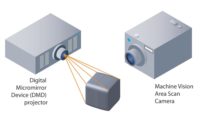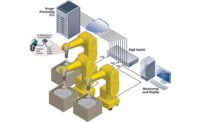Fueling Innovation in Machine Vision
Advances from the networking industry are again set to help support next-generation imaging systems.

The cabling flexibility, extended reach, and mulitcasting capabilities of GigE Vision over NBASE-T bring performance and cost advantages to medical imaging applications. Source: Pleora

With NBASE-T technology, system designers can leverage inexpenisve, long-distance cabling to lower system costs and simplify installation and maintenance. Source: Pleora


Machine vision has thrived on the manufacturing floor, and is bringing new levels of insight to medical, security, and transportation applications, thanks in part by adopting technologies perfected for other markets.
One of the most significant game changers for machine vision was the GigE Vision standard, which borrowed from established networking and telecom standards to solve cabling, networking, and multicasting challenges in imaging systems. In addition, the standard has afforded imaging system designers with greater access to lower cost, widely available, field-proven components.
As vision systems become more complex, with multiple imaging sources outputting millions of pixels for real-time processing and display, a data capacity crunch is a looming hurdle for designers. Advances from the networking industry are again set to help support next-generation imaging systems, with NBASE-T 2.5G and 5G-BASE-T technology emerging as a solution to help designers address the bandwidth gap.
Introducing NBASE-T Technology
The NBASE-T specification defines a new type of Ethernet signaling that boosts the speed of twisted-pair cabling well beyond its designed limit of 1 Gbps to support 2.5 and 5 Gbps speeds at up to 100 meters. The specification supports autonegotiation between the new NBASE-T rates, and slower 1 Gbps rates, or—if the network infrastructure supports it—10 Gbps.
The specification is governed by the NBASE-T Alliance, a consortium of over 40 companies representing all major facets of networking infrastructure. Alliance members are focused on encouraging the widespread use and deployment of 2.5G and 5G Ethernet through promotion of the IEEE 802.3bz standard, and testing and compliance programs to facilitate the development and deployment of interoperable products.
NBASE-T technology was initially developed to help existing campus networks meet new bandwidth demands created by data-hungry mobile devices, Internet of Things applications, high-definition video streaming and teleconferencing, and quality of service demands for multiple users. With new 802.11ac wireless access points aggregating up to 5 Gbps of throughput, designers struggled to find a cost-effective solution to connect access points and local networks.
By boosting the bandwidth capability of the large installed base of Cat5e and Cat6 cabling, NBASE-T solutions enable users to accelerate their networks in the most cost-effective, least disruptive manner. Beyond solving capacity challenges for wireless local area networks, the technology is also being used to connect client and desktop PCs to Ethernet switches, network attached storage devices to wired network infrastructure, and gateways for cable and telco triple-play voice, video, and data services.
NBASE-T and the Vision System Design
NBASE-T technology offers a natural evolution for high-performance imaging thanks to its bandwidth support, low-cost cabling, and compatibility with the GigE Vision standard.
With GigE Vision over NBASE-T and IEEE 802.3, designers can transmit uncompressed images at throughputs up to 5 Gbps over Cat 5e copper cabling and 10 Gbps over Cat 6A copper cabling. The extended-reach, flexible, and field-terminated cabling can be easily routed through systems to ease installation and maintenance.
One of the benefits of the GigE Vision standard is that it is agnostic to the physical layer. This has enabled manufacturers to create 10 GigE and 802.11 wireless interface solutions that communicate using the GigE Vision standard. Similarly, designers can create NBASE-T cameras and vision systems that are natively compatible with GigE Vision compliant software. An NBASE-T network interface card (NIC) and Gigabit Ethernet NIC are treated the same by Windows, Linux, and other operating systems. This means existing GigE Vision-compliant software and software development kits (SDKs) are compatible with NBASE-T without any modifications.
System-level, PHY, and component products compatible with the NBASE-T specification are already shipping, with more products in development scheduled for release over the next 12 months including GigE Vision over NBASE-T solutions for cameras, X-ray panels, and other imaging devices.
New Imaging Application Opportunities
NBASE-T technology promises to help imaging system manufacturers and designers meet increasing bandwidth requirements, while taking advantage of existing cabling in retrofit upgrades and less expensive, field-terminated cabling in new installations.
For example, designers can upgrade quality inspection systems to increase throughputs while employing GigE Vision over NBASE-T solutions to transmit higher bandwidth video over installed copper cabling. Video can be multicast from multiple imaging sources to reduce computing and component costs in distributed and pipeline processing systems.
Designers are also evaluating GigE Vision over NBASE-T video connectivity for flat panel detectors (FPDs) used in medical imaging applications. GigE Vision over NBASE-T video interfaces are especially beneficial in fluoroscopy systems that minimize a patient’s exposure time by using multiple moving X-ray sources to irradiate tissue from numerous incremental angles in just seconds. X-ray images are converted into a GigE Vision-compliant video stream and transmitted over long-reach Cat 5e cabling to processing and analysis equipment located outside the sterile environment. The video processor then creates a composite image from the multiple image sources that is then multicast over the Ethernet network to various displays.
Continuing Evolution
NBASE-T technology joins a growing list of recent technology advances, including GigE, 10 GigE, USB 3.0, and wireless, that are now playing a key role machine vision. For imaging system manufacturers, these new capabilities are helping simplify design, lower costs, and enhance performance for traditional machine vision applications, while supporting the migration of vision expertise into new markets.
Looking for a reprint of this article?
From high-res PDFs to custom plaques, order your copy today!







